
15 minute read
in the trenches
Father Matthew Habiger’s fight to promote Natural Family Planning
Article by Dan Madden | Photos by JD Benning
Father Matthew Habiger understands why so many people turn a deaf ear to him.
“If something is nonsensical to you and it requires self-discipline, why bother,” he says matter-of-factly. “We have the technology, why not use it?”
He notes that 85 percent of Catholics of child-bearing age are using contraception. Of those Catholics, 40 percent have chosen sterilization. When they hear Natural Family Planning they often think of the antiquated and faulty “rhythm Method,” he admits.
Father Matthew is bringing his experience and connections from 10 years with Natural Family Planning Outreach to a National Summer Institute co-sponsored by NFPO and Benedictine College July 11-16 on the B.C. campus. Father Matthew says the central question to the institute is: “How do you retrieve something we’ve lost: God’s plan for marriage, spousal love and family?”
Father Matthew and his counterparts in the Natural Family Planning movement directly link this use to the 50 percent divorce rate among those same Catholics. “It is corrosive to the marriage bond,” he says. “Contraception destroys the natural connection between love and life. The marital act has profound meaning. It means that the man and woman intend to make the total personal gift of self to the other. “
There are many people sitting on the fence, he says. “They know what the Church teaches, but they don’t know why. They know the dos and don’ts but they don’t know the whys. We are appealing to anyone who brings an open mind and a good heart.”
The institute, while open to the public, is focused on three primary groups: Marriage preparation and health science teachers; clergy and diocesan communication officers; and medical professionals and hospital administrators and staff.
Speakers will include: Dr. Janet Smith, chair of life ethics at Sacred Heart Major Seminary, Detroit, Mich.; archbishop Joseph F. Naumann of the archdiocese of Kansas City in Kansas; John allen Jr., Vatican analyst for CNN and National Public radio, all Things Catholic at the National Catholic reporter, and author of “The Future Church;” Dr. robert P. George of Princeton University, co-initiator of the “Manhattan Declaration”; and Dr. Jan Hemstad, president of the Catholic Medical association and Medical Doctors of the Catholic Medical association. There will also be presentations by Father Matthew and his colleague in the Natural Family Planning Outreach, Father Daniel McCaffrey.
Father Matthew and his partner in the institute, Benedictine College’s Matthew Tsakanikas, a doctoral candidate at the Pope John Paul II Institute on Marriage and Family in rome, are interested in the fence riders.
“Of Catholic gynecologists, only one percent is with us,” says Father Matthew who can quote statistics like a man who has returned to them time and again looking for something he might have missed. “That’s pathetic. The other 99 percent are part of the problem. a couple hears about God’s plan from their pastor but then goes to their Catholic ob-gyn and gets prescribed the pill. If our main allies aren’t doing what they are supposed to, we aren’t going to go very far.”
The problem, Father Matthew says, is that the doctors never received training on Natural Family Planning in medical school, and many doctors don’t understand how effective it is. They don’t realize, he says, that in many cases a couple trained in Natural Family Planning can have a more than 98 percent success rate, and that NFP is an effective way to overcome infertility. In addition, pharmaceutical corporations that produce contraception put a lot of money and energy into influencing doctors to prescribe their products. “There is big money in contraception,” he says. To counter this, this summer’s institute will offer doctors 14 hours of continuing medical education credits and provide speakers that are respected medical professionals. “We have to have peers talking to peers,” Father Matthew says. “If we can get one Catholic ob-gyn to convert that will be a success. Our goal is to get that one percent up to five percent.” Father Matthew continues to fly to California, New york, South Carolina, Texas, New Mexico, Pennsylvania and even africa. He goes wherever he is invited, preaching the gospel of Natural Family Planning. The tall angular priest looks younger than his 69 years, and his zeal shows
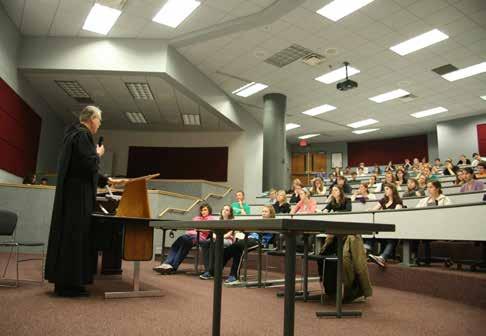
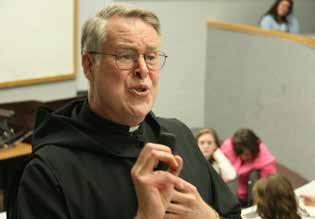
no sign of the fatigue of someone facing what some would say are insurmountable odds. Catholics still are using contraception in massive numbers. Father Matthew and his message are received well wherever he goes. He takes this as a sign of fertile ground. But he is blunt in his analysis. He and the relatively small band of movement champions crossing the country aren’t enough. He is critical of pastors and even bishops who won’t take the message of God’s plan for marriage, spousal love, family and Natural Family Planning to the pulpit. He decries ignorance of NFP in the community of marriage preparation leaders. a moral theologian, Father Matthew spent 10 years immersed in the pro-life movement, travelling internationally to spread its message and he still champions its cause and cheers the work of the U.S. Bishops in this area. But he is convinced that contraception is the “taproot feeding the culture of death,” vital to the movement. and he says many clergy are plainly afraid to speak of it from the pulpit out of a fear of hurting feelings or offending Catholics who are so overwhelmingly using contraception. “There is a price to pay for speaking out on God’s plan for marriage, spousal love and family. Some people may reject you while defending their lifestyle,” Father Matthew says. “But there also is a price to pay for our silence at the pulpit: a 50 percent divorce rate, emotionally scarred children, an 80 percent cohabitation rate, an 85 percent contraception rate with 40 percent of those couples now sterilized and a drought of vocations to the priesthood and religious life. We clergy must decide which price we are willing to pay.”
The Summer Institute, which was made possible thanks in part to a grant from Our Sunday Visitor, which paid for almost all publicity, will be an annual event.
But Father Matthew calls it simply a step in the right direction.
“These values need to be in every diocese,” he says. “It needs to be in every parish.”
In the meantime, Father Matthew continues to travel and talk to anyone who is interested. He sends an e-mail newsletter to 450 editors, family life directors and Natural Family Planning coordinators across the country. He writes columns. He delivers homilies. He takes heart that anything good must happen one person at a time.
“Here I am in my Podunk room at my computer,” he says with a laugh. “Just look at the damage I can do.”
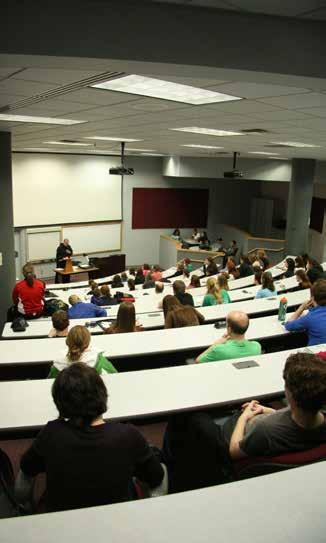
For more information on the Institute, visit the Website: Benedictine.edu/nfpo, or contact the coordinator, Matthew Tsakanikas, work phone: 913-360-7571; cell phone: 913-370-0197. E-mail: mtsakanikas@benedictine.edu.
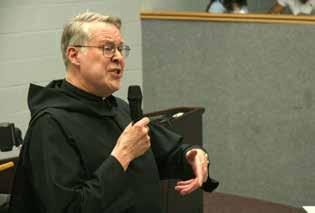
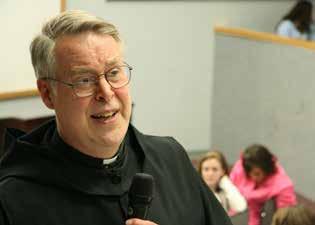
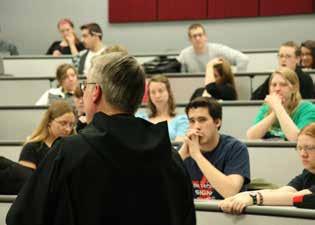
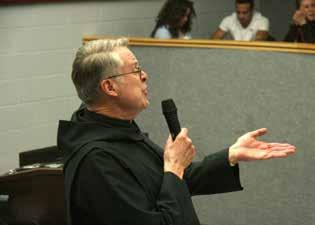
KANSAS MONKS a Grateful Response liturgy & the life of the church Explore – Commit – Transcend

Children at the breast give themselves without reflection to being nourished, and their mothers give themselves in quiet reflection to the nourishment of their child, but before long the infant is ready for solid food.
Toddlers give themselves fully to running about without consideration of the consequences, which their parents anticipate by moderating their running and providing a safe environment for freedom at play until the children themselves develop in their capacity to moderate their own behavior.
School children give themselves to discovering the new society beyond the home and to making friends with their classmates, yet the moderating hand of the teacher helps the children to discern and acquire appropriate social skills for their peer group.
Teenagers may give themselves to developing an awareness of the greater society and to developing a reflective understanding of themselves, their personal interests and gifts, and they may give themselves to the high ideals which they develop with the inspiration of mentors. young adults learn to give themselves in reflective and measured ways not only to their professional undertakings but also to developing adult friendships and lifelong commitments to others. Their professional and personal commitments will have a formative effect on them, making them into the adults they are yet to become.
New parents may realize their child’s utter dependence upon them and will soon enough learn that their children are affected in their innocence by their parent’s mistakes, weaknesses and limitations. Upon reflection they may perceive how people throughout the world are interconnected in similar ways whereby the innocent suffer the consequences of others’ often unreflected actions. This realization may lead them to a more universal social awareness.
Those at the prime of their careers may give themselves to the broader society through various forms of service, one that looks to generations for its rewards.
Senior citizens may reflect upon the course of their lives and seek to integrate the many scattered events in a narrative that shows the meaning of their self-gift in every age and how their gift
of themselves to others at each step provided the impetus for their ongoing development. The process of dying may become for some people the final act of self-gift in trust as we anticipate, like the child before coming from the womb, being born into another mode of existence we already know from a lifetime of preparation. at each stage of life we are called to give ourselves to others and, as we learn at each stage to represent ourselves accurately to others, we come to a greater awareness of ourselves in an everexpanding society until we realize that in every single act of kindness all of humanity once again knows salvation. This is what it is to live according to a vocation. I recently attended the solemn profession of monastic vows of Brother Matthew at ealing abbey. One small detail of the rite Father Daniel McCarthy struck me in a new way. after reciting his vows formula he took his vows document to the altar and set it on top of the book of the gospels and signed it, as we do. Then the document is left on the altar as the Mass continues and the gifts of bread and wine are brought forward, often by a member of the family. When a monastic presents her or himself for their profession of vows, they offer themselves in a committed relationship to the monastic community and, through the service of the community, to the church and society as a whole. Spouses do the same when they give themselves to one another in marriage, and through their exclusive commitment to one another they learn to give themselves in the greater society. This process of giving one’s self in committed relationship to another, to a community and through these to an ever expanding embrace of humanity is repeated at every eucharist we celebrate, when we take simple gifts of bread and wine and process them up to the altar and so present ourselves as gift. Our gifts are prepared and placed on the altar to become the bodily gift of Christ to us so that we who share of his body and blood may become one body in Christ. These exchanges of self as gift by successive steps in the eucharistic liturgy and throughout our lifelong human development are represented architecturally by the combination of an altar surmounted by a
The Cathedral of Trapani, Sicily, has a cubic altar with ciborium, the vaulted canopy over a half-sphere ciborium over it. Together they express an altar. One familiar example is the the exchange of self-gift that occurs in the Eucharistic liturgy and in many ways throughout one’s life. The altar expresses the gifts from the four cardinal directions and the ciborium expresses the gift of the Holy Spirit upon the gifts. baldachin over the altar at St Peter’s Basilica in rome. On the underside of the baldachin is the image of the Holy Spirit whom we pray to come upon our gifts of bread and wine which are placed directly below on the altar. another example is the cubic altar of the cathedral of Trapani, Sicily, with its semi-circular ciborium above it. The cubic altar expresses that our gifts come from the four corners of the earth to be presented here, and the ciborium expresses the transform-
photo by Father Daniel McCarthy
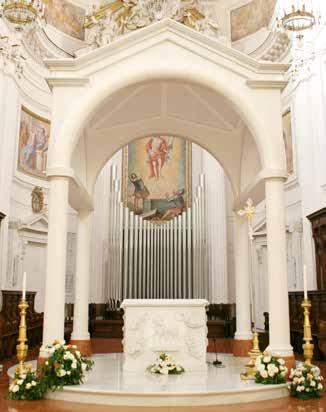
ing power of the Spirit so that these may become the bodily gift of Christ to make us one body one spirit in Christ.
The large chapel at Mount St Scholastica has such a ciborium over its altar, and the big chapel at St. Benedict’s abbey has a projection in the ceiling directly above the altar to express the divine self-gift given in the gifts shared below. St. Benedict’s Parish Church, our former abbey church in atchison, still retains its ciborium although the gifts are now placed on the new altar some distance in front. all of these are architectural monuments to the exchange of gifts of self between humanity and divinity in the eucharist. as we present ourselves at these altars and as we come under these ciboria time and again throughout the course of a lifetime, these monuments stand as witnesses to the many and changing ways in which we give ourselves to explore, to commit and to transcend. The underside of the baldachin at St. Peter’s Basilica, Rome, where the image of the Holy Spirit is placed directly above the gifts of bread and wine placed on the altar.
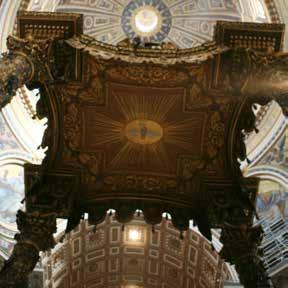
photo by Father Daniel McCarthy
Somos Irmãos
we are brothers
In my previous column I described how, in the past, monks of St. Joseph Priory exercised creativity, initiative and leadership in their service roles. In this article, I write of on-going efforts to promote leadership through continued monastic and academic formation. revealing their vision and experience, during the process of monastic Visitation to Saint Joseph Priory in December 2009, both abbot Barnabas Senecal and abbot Joaquim de arruda Zamith highly recommended promoting leadership among our monks.
We see that the monastic movement’s spread was concurrent with the expansion of Christianity, on all sides of the Mediterranean. What held them in common was the written word (Sacred Scripture) - radically following the risen lord, and giving witness of His presence.
Many monastic founders and leaders were men and women who excelled in learning. long before monasteries became centers of learning, monks were encouraged to read and study. They were active figures in defense of the Christian heritage. Some elaborated treatises on virtuous living, theological tracts, biblical reflections and homilies, writing in Coptic, Greek and latin. Others composed rules for the cenobitic life–those members of a religious order living in common. Such works are not only patristic–relating to the writings of the early church fathers–but also classical literature.
There is no mold for making a monk. Instead, in formation, one must be aware of what “form” one uses. What shape, size, density, and configuration do we want? What makes a praying, fraternal and hospitable monk?
In the School of the lord´s Service–as St. Benedict´s describes his monastery–monks may wear different hats in their variety
of services. In Father eugene Dehner’s autobiography he wittily writes about his three hats: the monk´s cowl, the professor´s mortarboard, the priest´s beret. “educate better to serve better” was a motto used by the State Department of education here in Goiás in the 1980s. The excellence Benedictine College maintains even today was founded on those same efforts to qualify monk professors during the years between 1930 and 1950. We also believe educational opportunities qualify monks to serve better – to be better monks. Consider the following: last October, Father Vinícius participated in a two-week Seminar on monastic formation, promoted by the Inter-Monastic Conference of Brazil. as diocesan coordinator of youth ministry, his leadership and enthusiasm are producing fruits. Father Joaquim Carlos presently is in rome for two months of intense studies on the rule of Benedict. as a clinical psychologist, retreat master and holding other leadership roles, these studies Prior Duane Roy will contribute to his vision of the Benedictine charism in today´s Prior - St. Joseph’s Priory world. Father rodrigo, current pastor of a newly-formed parish, has many opportunities for leadership in planning, evaluating and initiating out-reach programs and concurrently is working on a degree in clinical psychology. Brother Carlos alberto, a recently professed member who already concluded three years of theological studies toward the priesthood, will begin a master´s degree in literature, specializing in translation and editing of texts. Father Josias earned a master degree in philosophy of education 20 years ago. among his students are leaders in all walks of life. He is a writer, retreat master, and lecturer. He contributes to the formation of young monks. In his Circular letter (Jan. 2011), abbot Primate Notker Wolf shares his vision for Benedictines today in secularized and religiously indifferent societies. “Community life,” he says “is a sign of Christian love, a witness of God´s presence in the world.” He invites those of us in poorer countries to contribute–by prayer, work and study–to the development of the specific regions where we are inserted, “as was once the case in europe.” acquired knowledge and qualification contributes to leadership capacity. Perhaps some consider leadership qualities less significant in monasteries or not as important as obedience. Vision of the future and conscious of signs of the times are of equal importance.



